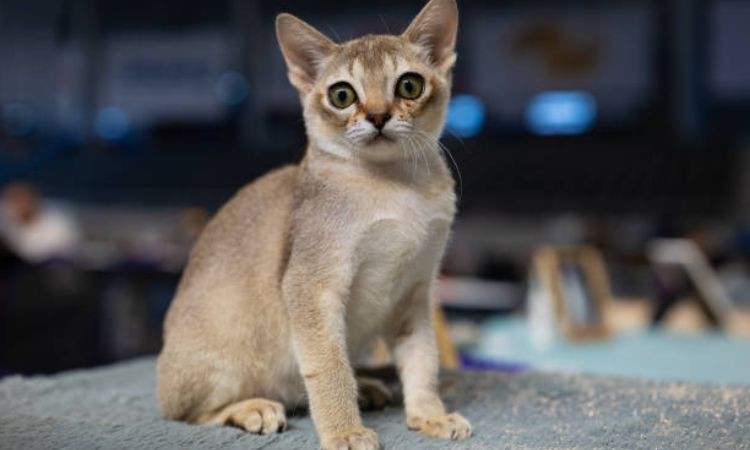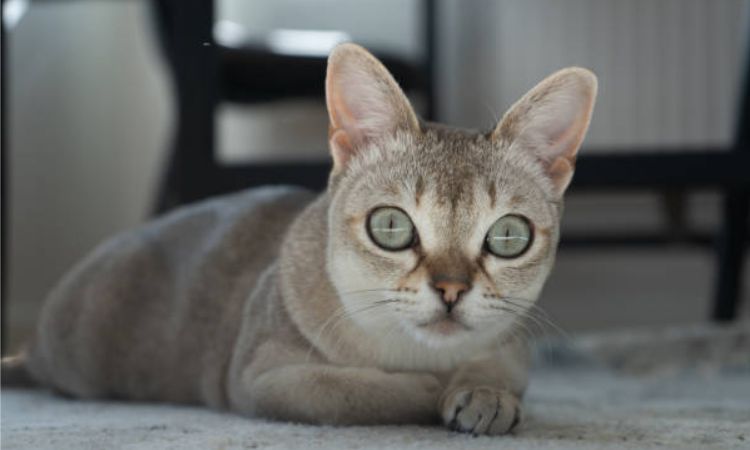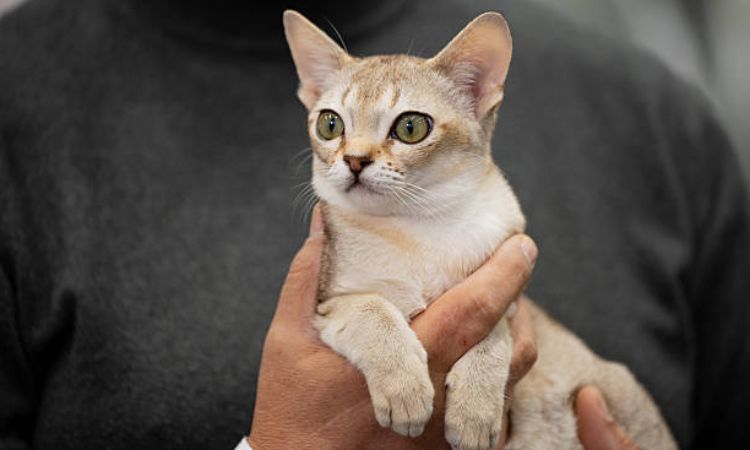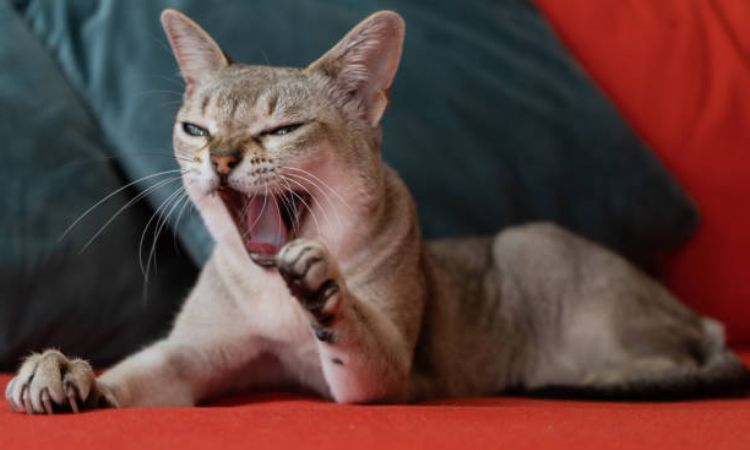Tiny but mighty, the Singapura cat packs a world of personality into a pint-sized frame. Known in Singapore as Kucinta, these little dynamos captivate with their sparkling eyes, oversized ears, and elegantly ticked coats, all crowned by a short, blunt tail.
Don’t let their small stature fool you Singapuras are playful, curious, and endlessly affectionate companions. Keep reading to discover everything you need to know about Singapura cat characteristics, size, and cost before bringing one home.

Singapura Cat Characteristics
The Singapura is a tiny cat with an outsized personality. While her petite frame may catch your eye, it is her playful, affectionate, and intelligent nature that truly defines this breed. Known for their social charm and boundless curiosity, Singapuras make lively, engaging companions for the right households.
1. Key Personality Traits
- Affectionate and People-Oriented (“Velcro Cat”): Singapura cats thrive on human companionship. They often follow their owners from room to room, sit on laps, snuggle in bed, and generally want to be involved in daily life. Their strong attachment to family members makes them excellent companions, though they may initially be cautious with strangers.
- Playful and Energetic: Despite their small size, Singapuras retain a “kitten-like” energy throughout their lives. They love to play, jump, climb, and explore, often turning any household object into a source of amusement. This playful energy makes them excellent for interactive games like fetch, chasing toys, and puzzle activities.
- Curious and Intelligent: This breed is highly inquisitive and mentally agile. Singapuras enjoy investigating new environments, climbing to high vantage points, and solving simple puzzles. Their intelligence also allows them to learn tricks and commands more easily than many other cat breeds.
- Social: Singapuras are friendly with children, other cats, and even dogs when properly introduced. They enjoy participating in family activities, though they may prefer a calm, structured environment over chaotic or noisy households.
- Vocal Level: While generally soft-spoken, Singapuras are capable of making their needs and desires known through gentle meows or chirps. They are not excessively vocal but will communicate subtly when attention or interaction is desired.
2. Living Needs and Interaction
- Thrives on Attention: Singapura cats form strong bonds with their owners and do not do well if left alone for extended periods. Without regular interaction, they may develop stress or separation anxiety.
- Loves to Be Up High: Climbing and observing from elevated positions is natural for this breed. They enjoy perching on shelves, cabinets, and shoulders, giving them a clear view of their surroundings and engaging them in household activity.
- Trainability: Thanks to their intelligence and curiosity, Singapuras are highly trainable. They can quickly learn simple commands, play “fetch,” or even help with household tasks, like opening doors or retrieving items, making them an interactive and entertaining companion.
Singapura Cat Size and Appearance
The Singapura holds the distinction of being the smallest recognized domestic cat breed. Adult females typically weigh around 1.8 kg (4 lbs.), while males average 2.7 kg (6 lbs.). Their height generally reaches up to 20–25 cm (8–10 inches) at the shoulder, making them exceptionally petite compared to most domestic cats. Despite their tiny stature, Singapuras are surprisingly athletic and strong, with well-developed muscles that support their energetic and playful nature.
Distinct Physical Traits
Coat
Singapura cats have a short, fine, and silky coat that lies close to the body. Their grooming needs are minimal, and they shed lightly, making them easier to maintain than many other breeds. Their smooth coat accentuates their sleek, compact physique.
Color and Pattern
The breed is recognized for a single coat color: Sepia Agouti, which features a warm ivory base color overlaid with dark sepia brown ticking. Each individual hair alternates between light and dark bands, giving the coat a subtle shimmering effect. The lighter underparts, including the chest, chin, and muzzle, highlight the cat’s delicate yet elegant coloring.
Head, Eyes, and Ears
The Singapura’s head is rounded with a short, blunt muzzle, giving it a distinctive, expressive appearance. Its large, almond-shaped eyes—commonly green, gold, or hazel—stand out against the sepia-toned coat and convey a perpetually alert, curious expression. The breed’s ears are large, slightly pointed, and deep cupped, further emphasizing its lively and attentive demeanor.
Body Build
Although small in size, the Singapura is muscular, sturdy, and well-proportioned. Its legs are strong and agile, supporting their natural tendency to climb, jump, and explore. The tail is slender, slightly shorter than the body, and ends in a blunt tip, completing the breed’s compact yet athletic silhouette.

Singapura Cat Health and Care
1. Lifespan
Singapura cats are generally healthy and live between 11 and 15 years, with some individuals reaching up to 18 years when provided with proper care and a stable environment. Their robust constitution is likely a result of their possible ancestry from street cats in Singapore, giving them resilience uncommon in some other purebred cats.
2. General Health Considerations
Genetic Conditions:
While the Singapura is a relatively healthy breed, prospective owners should be aware of certain breed-specific health risks:
- Pyruvate Kinase Deficiency (PKD): This genetic disorder affects red blood cells, potentially leading to anemia, fatigue, jaundice, and weight loss. Testing is available to identify affected cats or carriers.
- Uterine Inertia (in females): Some Singapura females may have weak uterine muscles, making natural birth difficult and often necessitating cesarean delivery.
Routine Veterinary Care:
Maintaining regular veterinary care is essential for long-term health. Recommended care includes:
- Core vaccinations to prevent common feline viruses such as rhinotracheitis, calicivirus, and panleukopenia.
- Dental hygiene through daily brushing with cat-specific toothpaste to prevent periodontal disease.
- Parasite prevention, including flea, tick, and heartworm control, as well as routine fecal exams for intestinal parasites.
- Annual check-ups to monitor overall health, detect early signs of genetic conditions, and maintain a healthy weight.
3. Grooming and Diet
Grooming:
Singapura cats have short, fine, and smooth coats that require minimal maintenance. Weekly brushing is usually sufficient to remove loose hairs, distribute natural oils, and provide bonding time. Additionally, owners should regularly:
- Check ears for debris or infections.
- Trim nails to prevent overgrowth.
- Brush teeth to maintain oral hygiene.
Diet:
Given their small size but high energy levels, Singapuras require high-quality, nutrient-rich cat food appropriate for their age and activity. Some important considerations:
- Feed small, frequent portions throughout the day to match their grazing habits.
- Ensure the diet supports lean muscle development and overall vitality.
- Consult a veterinarian before introducing raw or specialized diets to ensure all nutritional needs are met.
4. Exercise and Enrichment
Singapura cats are naturally athletic, playful, and curious. Mental and physical stimulation is crucial to prevent boredom and promote a healthy lifestyle:
- Interactive play: Use puzzle toys, fetch games, and toys that encourage chasing or hunting instincts.
- Climbing and exploration: Tall cat trees, shelves, and climbing structures allow them to satisfy their love for heights.
- Environmental enrichment: Rotating toys, hiding treats, and puzzle feeders provide mental stimulation and encourage problem-solving.
By providing a safe, stimulating environment, owners ensure that their Singapura remains happy, healthy, and engaged.

Singapura Cat Cost and Budgeting
1. Initial Acquisition Cost
- Reputable Breeder Price: $1,200–$2,000
Singapura cats are among the rarest cat breeds, and show-quality individuals can command higher prices. - Adoption Fee: $75–$150
Due to their rarity, Singapura cats are seldom available in shelters. Adopting one may not come with a breeder’s certificate, but it is a more affordable option.
Note: The breed’s rarity not only increases the purchase price but may also extend the waiting period to acquire a cat.
2. One-Time Setup Costs
Before bringing a Singapura home, you will need to prepare both supplies and initial veterinary care, with total costs typically ranging from $550 to $1,000, depending on location and choices:
Supplies:
- Litter box: $18
- Litter scoop: $7
- Cat bed: $25
- Carrier: $35
- Scratching posts / cardboard inserts: $0–$10
- Toys: $40
- Food & water bowls: $10
- Brush & nail clipper: $15
- ID tag & collar: $20
Initial Veterinary Care:
- Spay/Neuter: $200–$400
- Vaccinations: $70–$250
- Microchip: $40–$50
- Initial vet visit / checkup: $50–$100

3. Annual / Ongoing Costs
After purchasing your cat and preparing supplies, you should budget for monthly and yearly expenses to maintain your Singapura’s health and well-being:
- Food: $40–$60 per month: High-quality, age-appropriate food is essential for their active lifestyle. Singapura cats prefer multiple small meals throughout the day.
- Litter & Environment Maintenance: $25–$50 per month: Includes cat litter, deodorizing sprays, and occasional replacement of scratching materials.
- Veterinary Care: $55–$165 per month: Routine check-ups twice a year, preventive treatments for parasites, additional vaccinations, and any necessary medical care.
- Pet Insurance: $10–$40 per month: Options range from accident-only coverage to comprehensive accident and illness plans, helping reduce unexpected veterinary costs.
- Grooming: $5–$10 per month: Minimal grooming is required: weekly brushing, ear cleaning, nail trims, and regular dental care.
- Entertainment & Toys: $20–$30 per month: Singapura cats are highly energetic and curious; interactive toys and climbing structures help keep them mentally and physically stimulated.
- Unexpected Medical Costs: Variable: Costs for emergency treatments or genetic conditions such as Pyruvate Kinase Deficiency (PKD) or uterine inertia in females.
Average Monthly Total: $110–$245; Costs may be higher during months requiring veterinary visits or specialized care.
Owning a Singapura cat means welcoming a small but lively companion into your home. With their playful energy, affectionate nature, and unique appearance, they can bring years of joy and companionship. Being aware of their care requirements, health considerations, and costs ensures you can provide a happy and healthy environment for your Singapura. Making an informed decision helps both you and your new feline friend start off on the right paw.






